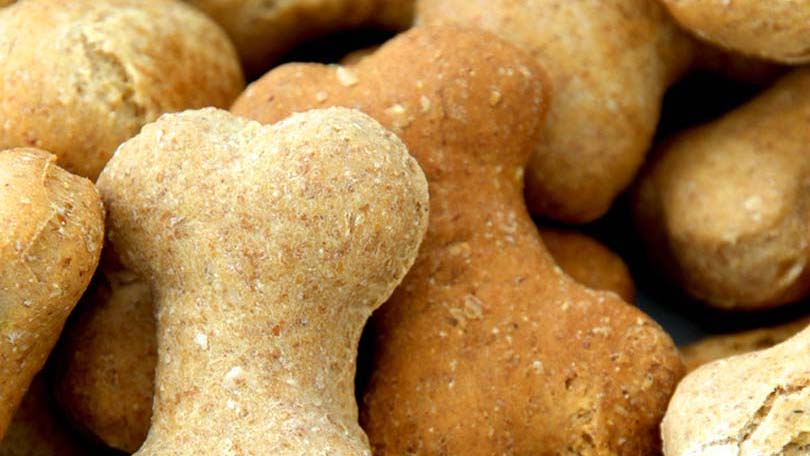
Dog treats come in all shapes and sizes with just about every ingredient a canine can crave but which do you give to your dog? Pet stores carry so many and picking the right one (or two or three!) can be overwhelming for a first-time owner or even a seasoned veteran of the doggy world!
What to look for in a treat
There are treats for training and rewarding and treats for giving your pooch something to keep him busy and out of trouble. There are going to bed treats, treats for car rides and treats for just being a darn good companion. The common thread through them all is that they are healthy, safe and not given to the point of tubbiness.
Mass Marketed Dog Treats
Dog treats like human treats are often full of sugar and salt to improve their taste or chemicals to preserve or enhance flavor and smell. Read the ingredients on all treats just like you would their food or your own store-bought cookies.
Safety is an issue with many types of dog treats. Something as simple as giving a dog a bone can lead to broken teeth, swallowed bits of broken off (and sharp!) bone or even a bone wedged onto a lower jaw that requires anesthetic and a bone saw to remove. This is not an exaggeration – ask your veterinarian about bones one day and he will give you the scary low-down on these natural dog treats. When picking out a bone at the pet store, look for a strong, straight femur at least 4” long (even for a small dog) and check it for cracks frequently while your dog is enjoying it. Avoid knuckle bones as the cartilage is easily chewed off and can lead to constipation or a blockage.
Often recommended by trainers for dogs that suffer from separation anxiety is for the owner to give a rubber toy stuffed with biscuits and peanut butter to the dog as they leave as a distraction. This is a marvelous way to overcome separation anxiety issues and is equally effective for young high activity dogs that need to have their energy put to good use versus eating the sofa. However, keep an eye on the toy and at the first sign of the rubber breaking down or the dog chewing bits off it, toss it out and buy a new one. That is a major surgery waiting to happen!
Homemade Dog Treats
Want to know exactly what is in the treats your dog enjoys so much? Try making your own. There are dozens of great recipe books available on making healthy treats at home. This is a great way to get the kids involved in ‘baking’ but they probably won’t ask to lick the beaters when you are finished!
Doggy Bakery Treats
If pureeing liver is not your idea of a fun way to spend a Sunday afternoon, take a walk to your local doggy bakery. These bakeries specialize in healthy, organic homemade style treats for your dog (and cat too!). They often cater to dogs with food allergies so if your dog has issues with, for example, wheat, beef and eggs, let them know and they will bake a batch of specialty cookies just for your dog. They are also fun places to hang out as most allow dogs into the store and frequently they have a walking or social club for dog lovers.
Specialty Packaged Treats
New in the last decade to the dog treat market is the small producer of healthy cookies similar to the bakeries but packaged and sold at various locals within the country. Like the bakeries, these are high-end and often organic or specialty driven treats that appeal to not only the taste buds of the happy canine but also the one with the money – the owner. They sport specialty ingredients like bison or venison and often smell better then the human treats lined up in a bakery or deli!
Special Note: Treats for Training
Treats for training and reward are usually small but pack a big wallop of flavor and smell – the smellier the better for most dogs!
There was a time not long ago where dog trainers thought it better to give only verbal reward during obedience sessions but this is no longer the case. Rewarding a dog for behaving correctly is the fastest and easiest way to train a dog especially if they have a high food drive (and who doesn’t?!?). Once the new trick or command is no longer new and the dog has mastered it, the treat is gradually taken out of the training sessions.
Most professional trainers recommend soft treats for training sessions, as they are easy to break apart so only a small amount is given with each command. They are also easy to swallow quickly and no chewing is required.
When working with treats whether it is a training tool or for management of issues such as separation anxiety, keep a keen eye on your dog’s weight. Treats for dogs are very much like treats for humans – full of calories! There are low calorie treats on the market as well as high fiber treats that work much the same way. The good thing is that dogs consider exercise a treat so working off the cals is almost as much fun as consuming them!
Treats are an excellent trainer and motivator for your dog just as they are for you and your kids. Watch the ingredients for chemicals or high sugar content and watch your pooch for signs of weight gain. Otherwise, enjoy – you know your dog will!





